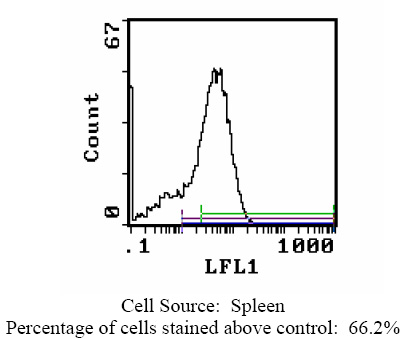CD44 Mouse Monoclonal Antibody [Clone ID: OX-49]
Specifications
| Product Data | |
| Clone Name | OX-49 |
| Applications | FC, IHC, WB |
| Recommended Dilution | Flow Cytometry. Western Blotting. Immunohistochemistry on frozen and paraffin sections. |
| Reactivities | Rat |
| Host | Mouse |
| Isotype | IgG2a |
| Clonality | Monoclonal |
| Immunogen | T cell blasts. Donor: BALB/c spleen. Fusion Partner: myeloma cell line NSO/1. |
| Specificity | This monoclonal antibody recognizes rat CD44 (Pgp-1), also called CD44H. This antigen is expressed on most leukocytes (except a sub population of B cells) and increases upon activation. The OX-49 antibody binds extracellularly to the standard (S) form on rat leukocytes but it is not known if they bind to the N-terminal region. It has also been reported that the antibody may bind to melanoma cell lines that express CD44V (splice variant form). |
| Formulation | PBS, 0.02% NaN3 and EIA grade BSA as a stabilizing protein to bring total protein concentration to 4-5 mg/ml Label: Biotin State: Liquid purified Ig |
| Concentration | 0.1 mg/ml |
| Purification | Protein G Chromatography |
| Conjugation | Biotin |
| Background | CD44 is a type 1 transmembrane glycoprotein also known as Phagocytic Glycoprotein 1 (pgp 1) and HCAM. CD44 is the receptor for hyaluronate and exists as a large number of different isoforms due to alternative RNA splicing. The major isoform expressed on lymphocytes, myeloid cells, and erythrocytes is a glycosylated type 1 transmembrane protein. Other isoforms contain glycosaminoglycans and are expressed on hematopoietic and non hematopoietic cells. CD44 is involved in adhesion of leukocytes to endothelial cells, stromal cells, and the extracellular matrix. |
| Synonyms | LHR, MDU2, MDU3, MIC4, CDw44, Epican, ECMR-III, HUTCH-I, Heparan sulfate proteoglycan, Hermes antigen, Hyaluronate receptor, PGP-1 |
| Note | Protocol: FLOW CYTOMETRY ANALYSIS: Method: 1. Prepare a cell suspension in media A. For cell preparations, deplete the red blood cell population with Lympholyte®-Rat cell separation medium. 2. Wash 2 times. 3. Resuspend the cells to a concentration of 2x10e7 cells/ml in media A. Add 50 µl of this suspension to each tube (each tube will then contain 1x10e6 cells, representing 1 test). 4. To each tube, add 1.0-0.5 µg* of this Ab. 5. Vortex the tubes to ensure thorough mixing of antibody and cells. 6. Incubate the tubes for 30 minutes at 4°C. 7. Wash 2 times at 4°C. 8. Add 100 µl of secondary antibody (Streptavidin-FITC) at 1:500 dilution. 9. Incubate the tubes at 4°C for 30-60 minutes. (It is recommended that the tubes are protected from light since most fluorochromes are light sensitive). 10. Wash 2 times at 4°C in media B. 11. Resuspend the cell pellet in 50 µl ice cold media B. 12. Transfer to suitable tubes for flow cytometric analysis containing 15 µl of propidium iodide at 0.5 mg/ml in PBS. This stains dead cells by intercalating in DNA. Media: A. Phosphate buffered saline (pH 7.2) + 5% normal serum of host species + sodium azide (100 µl of 2M sodium azide in 100 mls). B. Phosphate buffered saline (pH 7.2) + 0.5% Bovine serum albumin + sodium azide (100 µl of 2M sodium azide in 100 mls). Results - Tissue Distribution: Rat Strain: Wistar Cell Concentration: 1 x 10e6 cells per test Antibody Concentration Used: 0.5 µg/10e6 cells Isotypic Control: Biotin Mouse IgG2a Cell Source Percentage of cells stained above control: Thymus: 96.3% Spleen: 66.2% Lymph Node: 89.9% |
| Reference Data | |
Documents
| Product Manuals |
| FAQs |
| SDS |
{0} Product Review(s)
0 Product Review(s)
Submit review
Be the first one to submit a review
Product Citations
*Delivery time may vary from web posted schedule. Occasional delays may occur due to unforeseen
complexities in the preparation of your product. International customers may expect an additional 1-2 weeks
in shipping.






























































































































































































































































 Germany
Germany
 Japan
Japan
 United Kingdom
United Kingdom
 China
China



